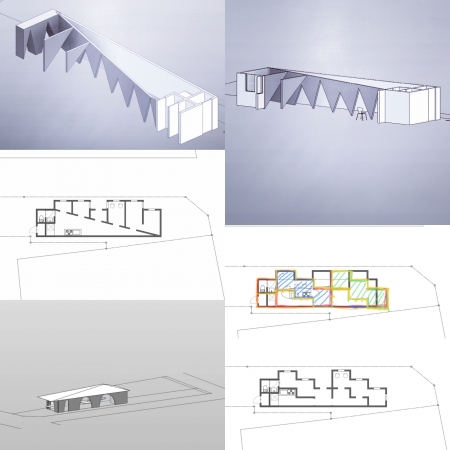人の動きを「即す」役割を与える
機能とは関係が無いところで人の動きを即すことを考えたならば、きっとプランや仕上げの素材だけでなく、様々な部位、例えば、柱や壁、開口部、階段なども捉え方を変える必要があるのではないかと思った。
柱や壁、開口部、階段などの部位はそれぞれの役割が、それを機能と呼んでもいいと思うが、あるので、その役割の秩序に則り配置されている。それらの配置は人の動きを即すことを考えて決められている訳ではないが、確実に人の動きに影響を与える。
ただ、その影響は「即す」ところまではいかずに、整流板のように「整える」、人の動きをその空間で秩序立てる程度であり、それは当たり前で、柱や壁、開口部、階段などの部位がそれぞれの役割に沿った秩序しか持ち合わせていないからである。
機能とは関係が無いところで人の動きを即すには、柱や壁、開口部、階段などの部位に別の秩序、それは人の動きを「即す」という役割を与え、その役割の秩序に則り配置してやらなければならず、それが捉え方を変えるということである。
"Give the role of" matching "people's movements"
If you think about adapting people's movements in places that have nothing to do with function, you will surely change the way you think about not only the plan and finishing materials, but also various parts such as columns, walls, openings, and stairs. I thought it was necessary.
Parts such as pillars, walls, openings, and stairs have their own roles, which can be called functions, but they are arranged according to the order of their roles. Their arrangement is not decided in consideration of the movement of people, but it certainly affects the movement of people.
However, the effect does not go to the point of "improving", but "arranging" like a rectifying plate and ordering the movement of people in the space, which is natural, such as pillars, walls, openings, stairs, etc. This is because each part of the body has only the order according to each role.
In order to adjust the movement of a person in a place that has nothing to do with the function, another order is given to parts such as pillars, walls, openings, and stairs, which gives the role of "according to" the movement of the person, and the order of that role. It must be arranged according to the above, which changes the way of thinking.


